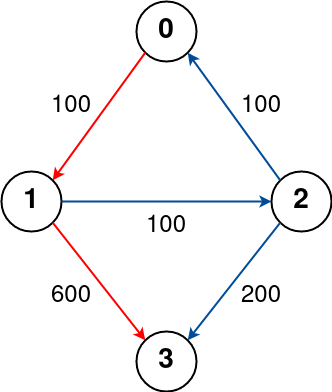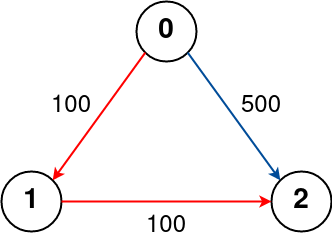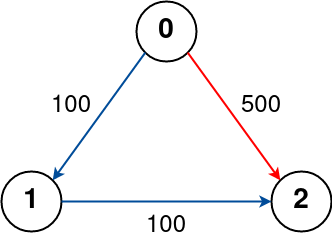- {x}
- K-th Symbol in Grammar
- Reaching Points
- Rabbits in Forest
- Transform to Chessboard
- Minimum Distance Between BST Nodes
- Letter Case Permutation
- Is Graph Bipartite?
- K-th Smallest Prime Fraction
- Cheapest Flights Within K Stops
- Rotated Digits
- Escape The Ghosts
- Domino and Tromino Tiling
- Custom Sort String
- Number of Matching Subsequences
- Preimage Size of Factorial Zeroes Function
- Valid Tic-Tac-Toe State
- Number of Subarrays with Bounded Maximum
- Read More...

Cheapest Flights Within K Stops
There are n cities connected by some number of flights. You are given an array flights where flights[i] = [fromi, toi, pricei] indicates that there is a flight from city fromi to city toi with cost pricei.
You are also given three integers src, dst, and k, return the cheapest price from src to dst with at most k stops. If there is no such route, return -1.
Example 1:

Input: n = 4, flights = [[0,1,100],[1,2,100],[2,0,100],[1,3,600],[2,3,200]], src = 0, dst = 3, k = 1 Output: 700 Explanation: The graph is shown above. The optimal path with at most 1 stop from city 0 to 3 is marked in red and has cost 100 + 600 = 700. Note that the path through cities [0,1,2,3] is cheaper but is invalid because it uses 2 stops.
Example 2:

Input: n = 3, flights = [[0,1,100],[1,2,100],[0,2,500]], src = 0, dst = 2, k = 1 Output: 200 Explanation: The graph is shown above. The optimal path with at most 1 stop from city 0 to 2 is marked in red and has cost 100 + 100 = 200.
Example 3:

Input: n = 3, flights = [[0,1,100],[1,2,100],[0,2,500]], src = 0, dst = 2, k = 0 Output: 500 Explanation: The graph is shown above. The optimal path with no stops from city 0 to 2 is marked in red and has cost 500.
Constraints:
1 <= n <= 1000 <= flights.length <= (n * (n - 1) / 2)flights[i].length == 30 <= fromi, toi < nfromi != toi1 <= pricei <= 104- There will not be any multiple flights between two cities.
0 <= src, dst, k < nsrc != dst
Solution Explanation for Cheapest Flights Within K Stops
This problem asks to find the cheapest flight from a source city to a destination city with at most k stops. We can solve this using either Dynamic Programming or a variation of Breadth-First Search (BFS).
Approach 1: Dynamic Programming
This approach iteratively relaxes edges in the flight graph. dist[i] represents the minimum cost to reach city i. We repeat this relaxation process k+1 times, representing up to k stops.
Algorithm:
- Initialization: Create a distance array
distof sizen, initialized to infinity except for the source city (src), which is 0. - Iteration: Iterate
k+1times (representing 0 to k stops). In each iteration:- Create a backup of the
distarray. - Iterate through each flight in
flights. For each flight(from, to, price), updatedist[to]with the minimum of its current value andbackup[from] + price. This represents the possibility of reaching citytovia cityfrom.
- Create a backup of the
- Result: After the iterations,
dist[dst]contains the minimum cost to reach the destination city. If it's still infinity, there's no path withinkstops.
Time Complexity: O(k*E), where E is the number of flights. The outer loop iterates k+1 times, and the inner loop iterates through all flights.
Space Complexity: O(N), where N is the number of cities. We use an array dist to store the minimum distances.
Approach 2: Depth-First Search (DFS) with Memoization
This recursive approach explores all possible paths from the source city to the destination city. Memoization is crucial to avoid redundant calculations.
Algorithm:
- Graph Representation: Create an adjacency list
grepresenting the flight graph. - Recursive Function
dfs(u, k):- Base Cases:
- If
uis the destination, return 0 (cost is 0 to reach the destination). - If
kis 0 or less (no more stops allowed), return infinity.
- If
- Recursive Step: Explore all outgoing flights from city
u. For each flight(v, p)to cityvwith pricep:- Recursively call
dfs(v, k-1)to find the minimum cost fromvtodstwithk-1remaining stops. - Update the minimum cost with
min(ans, dfs(v, k-1) + p).
- Recursively call
- Memoization: Store the result of
dfs(u, k)inmemoto avoid redundant computations.
- Base Cases:
- Result: Call
dfs(src, k+1)to start the search. Return -1 if the minimum cost is still infinity.
Time Complexity: O(VE), where V is the number of vertices (cities) and E is the number of edges (flights). The worst-case scenario involves exploring all possible paths. Memoization significantly improves performance by reducing redundant calculations, although the worst-case complexity remains the same. Space Complexity: O(VK) due to memoization. We store the results for each city and number of stops.
Code Examples (Python, Java, C++, Go): The code examples provided in the original markdown are correct implementations of both approaches. The Python example uses the @cache decorator for memoization, which makes it concise. The Java, C++, and Go solutions handle memoization manually. They also use adjacency matrices instead of adjacency lists, potentially leading to a larger space complexity if the graph is sparse. Using adjacency lists would typically be more efficient for sparse graphs.
The choice between the two approaches depends on the specific characteristics of the input data. For large graphs with many flights, the dynamic programming approach (Approach 1) might be more efficient due to its simpler iterative nature. For smaller graphs or cases where the maximum number of stops (k) is relatively small, the memoized DFS (Approach 2) could also be efficient.